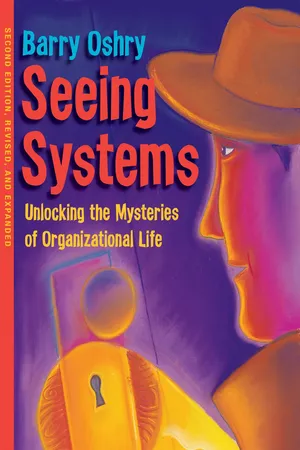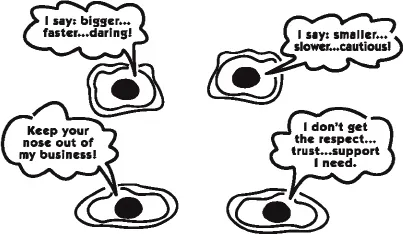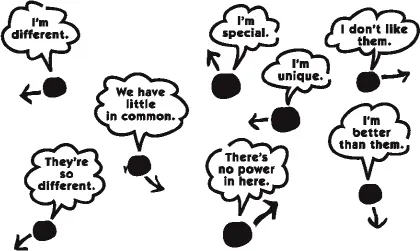
Seeing Systems
Unlocking the Mysteries of Organizational Life
Barry Oshry
- 240 páginas
- English
- ePUB (apto para móviles)
- Disponible en iOS y Android
Seeing Systems
Unlocking the Mysteries of Organizational Life
Barry Oshry
Información del libro
When breakdowns occur in organizational life, the tendency is to blame them on the personalities, motivations, and abilities of the individuals involved or on the specific characteristics of one's organization. Barry Oshry demonstrates how everyday breakdowns stem from our failure to see how human systems shape our feelings about ourselves and our relationships with other individuals and groups. He shows how we can transform "system blindness" into system sight, enabling us to live and work together in productive partnership. Based on Oshry's 30+ years of studying human interaction in social system life, Seeing Systems is profound in its implications while being easily accessible. In addition to illustrative cases and solid systems theory, the book is populated with pinballs; talking body parts; mysterious "swimmers"; amebocytes, slugs, and earthworms; dances of blind reflex; and tunnels of limited options. The result is a unique foundation for revolutionizing our understanding of system life.This new edition is revised throughout and features an extensive new section on having the wisdom and courage to face and work with the reality of uncertainty, a hopeful antidote to today's righteous battles of certainty versus certainty. The new epilogue describes how Oshry is currently using theater, blogs, and podcasts to extend his multipronged revolution aimed at transforming system blindness into system sight.
Preguntas frecuentes
Información
SEEING PATTERNS OF PROCESS
Act III
Scene 1 describes the consequences of process blindness.
Scene 2 deals with the transformation of process blindness into process sight.
Scene 3 the politics of system processes
Scene 4 the challenge of robust systems
Scene 1
Process Blindness
36 Are You Sure You Have It All?
37 Turf Warfare, Alienation, and
GroupThink: The Dance of Blind Reflex
Continued
Executive Summary
- Top group members become territorial and fall into turf battles with one another.
- Middle group members become alienated from and competitive with one another; they never become a group.
- Bottom group members become a cohesive entity, and they fall into pressuring one another into conformity or GroupThink.
- When relationships among group members break down, the explanations are tied to the personal characteristics of the individuals involved.
- And since the explanations are personal, so are the “solutions”: fix, fire, rotate, avoid, separate (“divorce”), control or avoid being controlled, therapize one party or both or all of them.
- But the fundamental issues keep coming back, because . . .
Tops Fall into Turf Battles

The Basic Turf pattern:
- Although Tops are collectively responsible for the whole system, they divide responsibility among themselves.
- Each Top becomes increasingly responsible for and knowledgeable about his or her own territory and decreasingly responsible for and knowledgeable about the territory of others and the whole.
- Tops become more concerned with what is good for their area than for the needs of the system as a whole.
- Instead of being in partnership with one another, Tops feel they need to protect themselves from one another.
Common symptoms of Top Turf issues:
- Lack of support. Tops feel unsupported by one another. They feel the need to protect themselves against unwanted incursions into their territory.
- Status/importance differences. Some areas of responsibility are considered more important to the operation than others. There are the more important Tops and the less important Tops.
- Resentment. Some Tops feel that other Tops are not carrying their fair share of the load.
- Control battles. There are struggles over the direction the system as a whole should take: Do we grow quickly or gradually? What is our orientation to our employees (or children)? Are we democratic? Autocratic? Laissez-faire? Do we diversify or stick to our core business? Do we take financial risks or play it conservatively?
- Relationship breakdowns. Relationships that began with promise deteriorate. Partners end up not talking to each other, or the relationship ends in separation, “divorce,” reorganization. (These promising new reorganizations often end up falling into the same DBR pattern.)
- System consequences. Tops send out conflicting messages, causing confusion throughout the system; there is limited cooperation across system lines, with the loss of potential synergies; redundant resources pile up in their separate stovepipes. All of this results in increased internal competition and decreased external competition.
Middle Group Members Become Alienated from One Another
The Basic Alienation pattern:
- Middle groups are nongroups. There is no sense of “We,” no common mission or purpose.
- Middles feel isolated from one another. Even when together (for example, in staff meetings), it is as if their energies are drawn away from one another.
- If you ask Middles what group they are part of, they are more likely to mention the groups they service or manage rather than their own peer group.

Common symptoms of Middle alienation:
- Unique. Middles feel unique, like they have little in common with one another.
- Competition. Middles are especially sensitive to how they are doing in relationship to one another. Am I better than others? Worse than others? Better off? Worse off?
- Evaluation. Middles are quick to make judgments about one another, and these judgments are generally based on surface characteristics: how the others dress; how they wear their hair; their physical characteristics, gender, skin color; how they speak; whether they are too emotional or too rational, and so on.
- No collectiv...